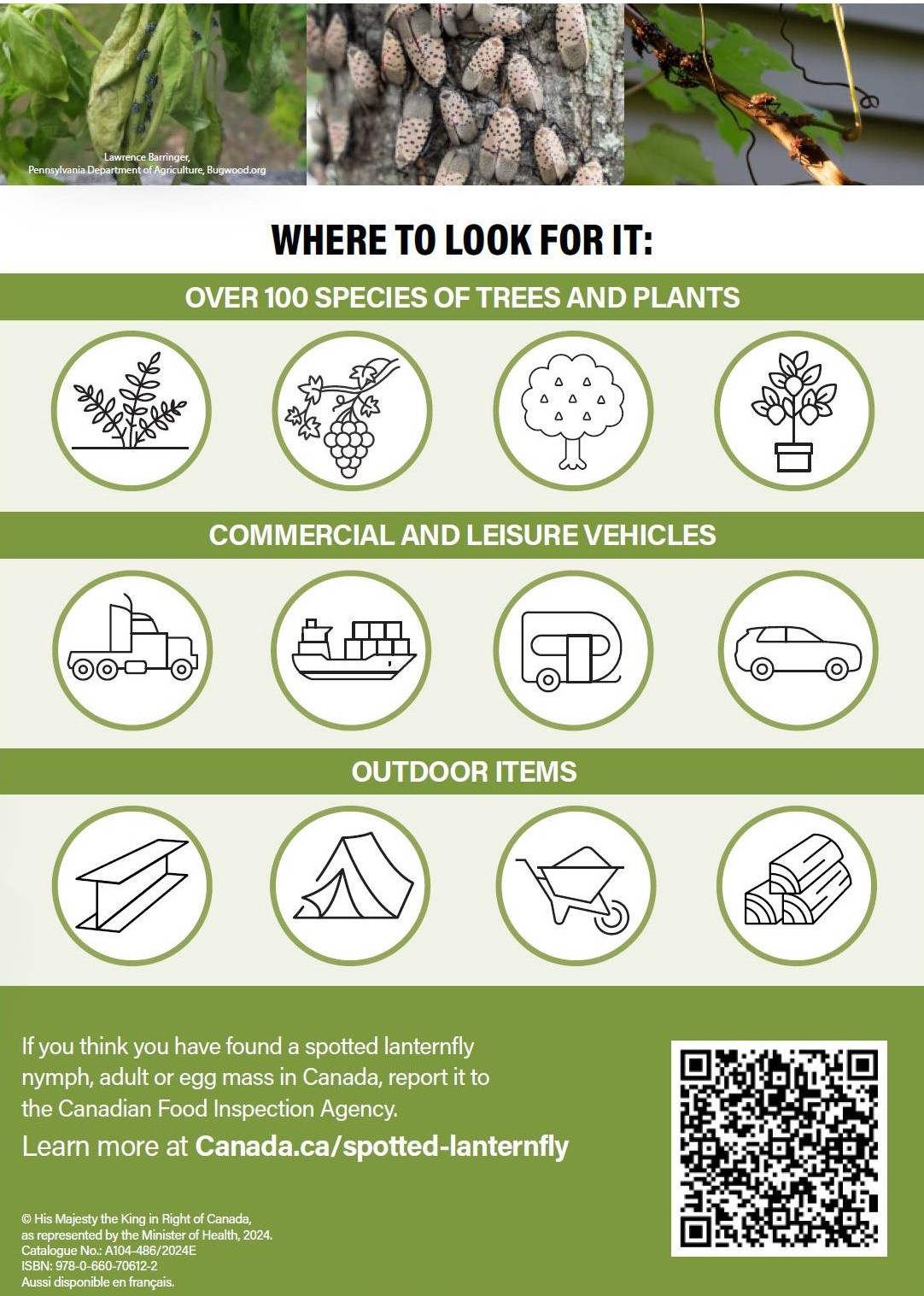On this page
- Information sheet for residents (8.5 x 11 inches)
- Infographic (8.5 x 11 inches)
- Double-sided information card (8.5 x 11 inches)
Information sheet for residents (8.5 x 11 inches)
An information sheet for residents about the spotted lanternfly, including where to look for it on your property and what to do if you find it.
Download infosheet (PDF - 297 KB)

Text version – Spotted lanternfly information sheet for residents
Spot it?
- Snap it – Take a picture or video of the insect or egg mass
- Catch it – Scrape eggs or catch the insect into a sealed container
- Report it – Contact the Canadian Food Inspection Agency immediately
You can help! Spotted lanternfly poses a significant threat to trees and shrubs in your community and can have a major impact on grape, tree fruit, wine, and ornamental industries in Canada.
About spotted lanternfly
- Spotted lanternfly (SLF) adults and nymphs can feed on sap from over 100 trees and plants
- Damage from feeding causes sap to flow out of tree or plant wounds, making them appear grey or black along stems, branches or trunk
- SLF feeding creates "honeydew", a sticky sugary substance that can lead to fungal growth (sooty mould) on surrounding plants and cause their eventual death
- SLF does not harm people or pets
What the Canadian Food Inspection Agency is doing
- Putting measures in place to slow the spread into Canada
- Surveying for signs of SLF in high-risk areas
- Working with industry, provincial and federal government departments to identify effective treatment options
- Building public awareness and education
What should I look for on my property?
- Egg laying: September – November
- Egg masses: October – September (Photo credit: Amanda Roe, Natural Resources Canada)
- Early nymph stage: May – July
- Late nymph stage: July – September
- Adults: July – December
If you see weeping wounds or plants covered in honeydew or sooty mould, take a look for SLF that might be nearby.
Where should I look?
- Trees and shrubs
- Gardening equipment
- Yard decorations
- Tents
- Campers
- Camping gear
- Sheds
- Patio tables and chairs
- Barbecues
Infographic (8.5 x 11 inches)
A single page infographic with information about the spotted lanternfly, including lifecycle images, and where to look for it.
Download infosheet (PDF - 238 KB)

Text version – Spotted lanternfly infographic
Spotted lanternfly is present in the United States and getting closer to the Canadian border. It could be devastating for Canada's wine, fruit and forest industries.
What to look for (lifecycle):
- Egg laying: September to November
- Egg mass: October to September (Photo Credit: Amanda Roe, Natural Resources Canada)
- Early stage nymph: May to July
- Late stage nymph: July to September
- Adults: July to December
Where to look for it:
- Over 100 species of trees and plants
- Commercial and leisure vehicles
- Outdoor items
If you think you have found the spotted lanternfly pest or egg masses in Canada, report it to the Canadian Food Inspection Agency.
Learn more at spotted-lanternfly.
Double-sided information card (8.5 x 11 inches)
A double-sided information card with images and information about what to look for, where to look and what to do if you find a spotted lanternfly.
5x7 inch printed cards are also available. To receive one, please contact us.
Download information card (PDF - 8 MB)


Text version – Information card
Spotted lanternfly is present in the United States and getting closer to the Canadian border. It could be devastating for Canada's wine, fruit and forest industries.
What to look for (lifecycle):
- Egg laying: September to November
- Egg mass: October to September (Photo Credit: Amanda Roe, Natural Resources Canada)
- Early stage nymph: May to July
- Late stage nymph: July to September
- Adults: July to December
Where to look for it:
- Over 100 species of trees and plants
- Commercial and leisure vehicles
- Outdoor items
If you think you have found the spotted lanternfly pest or egg masses in Canada, report it to the Canadian Food Inspection Agency.
Learn more at spotted-lanternfly.